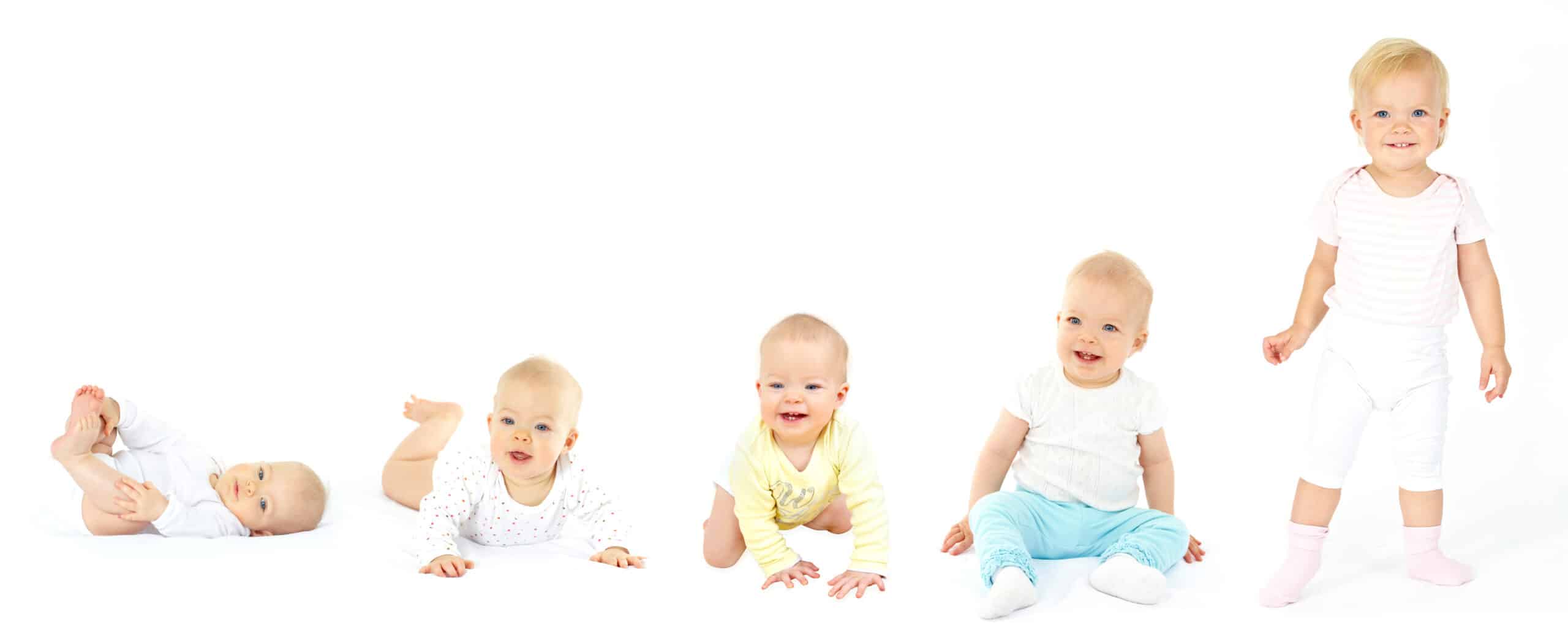As parents we become engrossed in our child’s development – especially when it’s our first. We get a sense of excitement and pride when they roll, crawl, sit, say their first words, feed themselves, and go to the toilet. But as a parent do we really know what is typical development and what should we be looking out for – I know I sure didn’t, I spent a lot of time googling things like “when do babies roll over?”.
Now as a Mum of 3 very busy kids and as a Paediatric Exercise Physiologist (Paed EP) I want to share my knowledge, about all things motor development in children.
Development is a continuous process of change in functional capacity – but more simply it is the ability to live, move and work within our environment. Development itself is certainly related to age, but is not at all dependent on age. For example the rates at which children learn can happen at different rates but along a similar timeline. My first baby didn’t walk until her first birthday, but my boy (2nd child) needed to get away from his sister, so was running around the house at 9 months and my 3rd child had two older siblings who did everything for her so didn’t start to walk until 15 months.
As a Paed EP, I am more focused on motor development and that’s what I’m going to focus on as you continue to read. Motor development is movement abilities, we look at the process of change and the outcome of movement. Now not all changes in movement are what we call development. For example if a child is walking on their toes and we provide some cues and exercises to promote a “typical” heel strike pattern this is not motor development, but rather motor learning – changes that are related to practice.
One final piece of the motor development puzzle that I’m interested in is motor control, that is how our brain and nervous system controls and coordinates muscles to move our bodies. You can see by understanding how our muscles are being activated and their timing will affect the way we learn patterns of movement and essentially develop our motor skills. Lack of skill development, or development of abnormal (atypical) movement patterns, is where my role as a Paed EP comes into play.
Motor development is so important in children. As they learn to move they have more experiences within their environment and the PLAY, which further motivates them to learn and develop other areas, not only physical areas like strength but areas of speech, emotions, relationships, social skills, senses and cognition. So when we think about it motor development is a fundamental area of development in children and there is huge amounts of evidence around the continuous cycle of sensory input and motor output.
When it comes to motor development there are two types and you will already know these. Fine Motor Skills and Gross Motor Skills. Fine motor skills use the small muscles of our hands, things like using lego or duplo, pencils, scissors and doing up buttons. These skills are essential in our daily lives.
Gross motor skills are those which require whole body movement and which involve the large muscles of the body to perform everyday functions, such as standing and walking, running and jumping, and sitting upright at the table. They also include eye-hand coordination skills such as ball skills (throwing, catching, kicking) as well as riding a bike or a scooter and swimming.
Gross motor skills are important to enable children to perform everyday tasks, such as walking and running, playground (e.g. climbing) and sporting skills (e.g. catching, throwing and hitting a ball with a bat). However, these are also super important for everyday self-care skills like dressing (where you need to be able to stand on one leg to put your leg into a pant leg without falling over) and climbing into and out of a car or even getting into and out of bed. Developing our gross motor skills helps our children to gain independence and self confidence.
The World Health Organisation gives us 6 key gross motor developmental milestones to help us identify when our children should be able to do these tasks and when we should seek some assistance from medical professionals.
Six Key Gross Motor Development Areas
- Sitting without Support: Average Age 6 months
- Standing with Assistance: Average Age 7.6 months
- Hans and Knees Crawling: Average Age 8.5 months
- Walking with Assistance: Average Age 9.2 months
- Standing Alone: Average Age 11 months
- Walking Alone: Average Age 12.1 months
Now you might say “What about rolling, or standing on their own etc” and I agree, in the resource we’ve developed we have noted other “milestones” that have been compiled from other research. You can grab that download at the bottom of this page.
Now there are red flags for development from 6 months right through to 5 years, and I’ve provided all of these to you in the same resource as the milestones. However there are some red flags which are relevant all the way through our little ones development, these are:
- Strong parental concern: Always trust your instincts as a parent – you know your child best
- Significant. loss of any skill that they may have already acquired. For example they were crawling and then stopped.
- Lack of response to sound or visual stimuli: remember we talked about the connection between sensory input and motor output.
- Differences between left and right sides of body in relation to strength, movement or muscle tone (stiff/floppy)
- Marked low tone (floppy) or high tone (stiff and tense) and significantly impacting on development and functional motor skills
Signs that your little one isn’t developing in a typical manner, not reaching milestones or loosing skills can be signs of childhood conditions relating to motor disorders and it’s super important to seek further advice if you are worried.
As promised – below is a helpful guide from 0 – 5 years. It contains information on:
- Milestones
- Red Flags
- Play Ideas
You can download the eBook by clicking here.
Other useful links
Queensland Health: Child Development Program
World Health Organisation: Motor Development Milestones
References
Haywood, K., & Getchell, N. (2020). Life span motor development (Seventh edition.). Human Kinetics.
Losquadro Liddle, T., & Yorke, L. (2018). Why motor skills matter: improve your child’s physical development to enhance learning and self-esteem. McGraw-Hill.
Multicentre Growth Reference Study Group, W., & de Onis, M. (2006). WHO Motor Development Study: Windows of achievement for six gross motor development milestones. Acta Pædiatrica (Oslo), 95(Supplement 450), 86–95. https://doi.org/10.1111/j.1651-2227.2006.tb02372.x


Very well presented. Every quote was awesome and thanks for sharing the content. Keep sharing and keep motivating others.
You’re so awesome! I don’t believe I have read a single thing like that before. So great to find someone with some original thoughts on this topic. Really.. thank you for starting this up. This website is something that is needed on the internet, someone with a little originality!